Silver gets its time in the sun
Silver is one of the most overlooked investments in the world of commodities. Despite its many unique qualities, it often sits unwarrantedly in the shadow of its shiny cousin – gold. That dynamic, however, could be changing. So far in 2024, physical silver has rallied 33%, hitting its highest mark in over a decade and making it one of the year’s best performing assets.(1) Gold, on the other hand, has fallen behind returning a respectable but comparatively muted 13% year-to-date.(2)
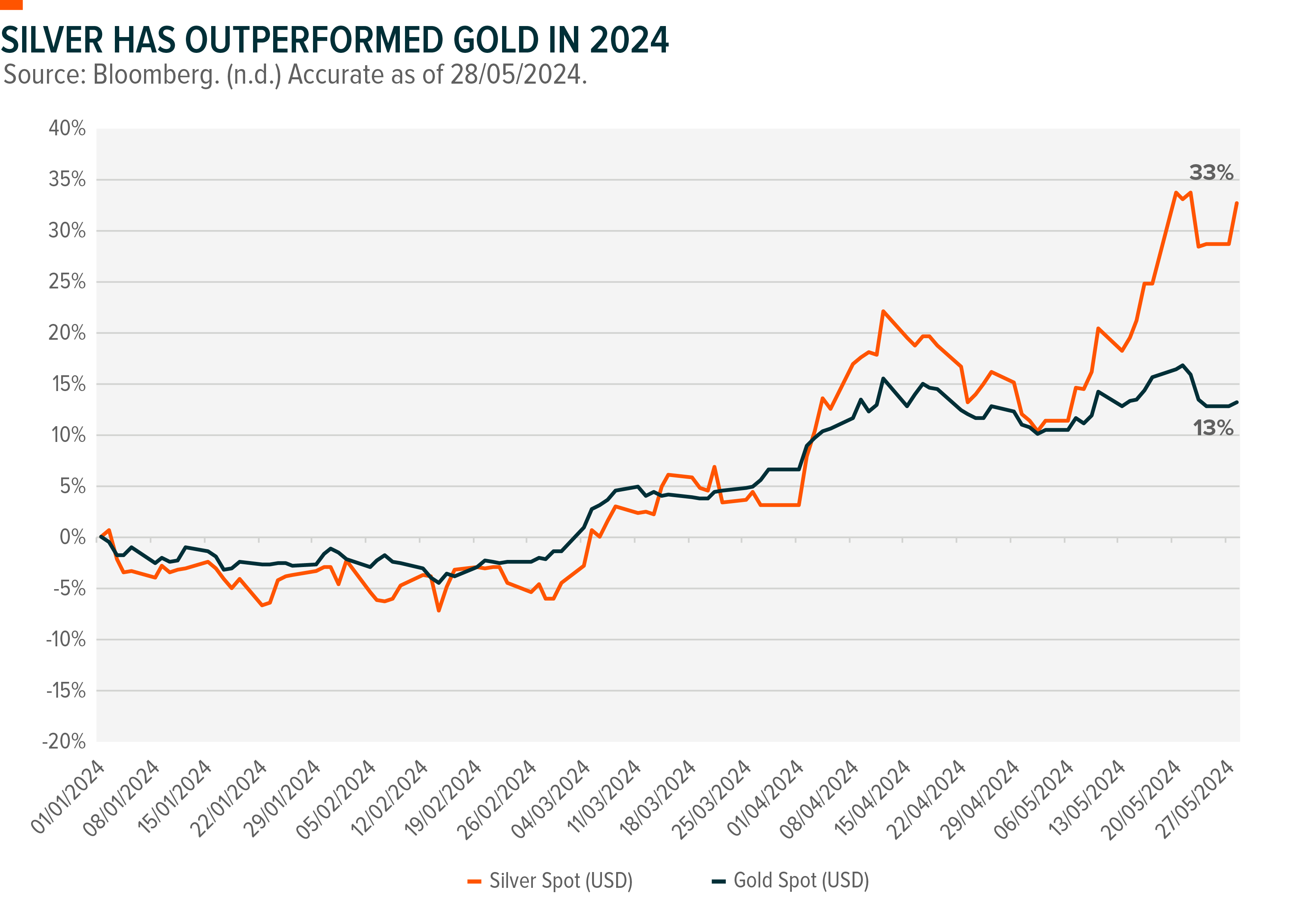
Past performance is not a reliable indicator of future performance.
There are many reasons why silver could be outperforming gold in the short term. For one, the publicly traded silver market is a lot smaller than gold, making it much more volatile.i Speculators will also note that the white metal has historically been a highly-correlated, leveraged play on the gold price – which would explain at least a part of the sudden surge.(3) But could it be more than that? Behind the façade of a speculators rally, investors appear to be positioning themselves for an ongoing shift in silver’s long term investment case – namely its critical role in the solar industry and electrification at large.
Key Takeaways
- Silver is an essential metal to the solar industry due to its unique qualities such as high reflectivity and near-perfect conductivity.(4)
- New solar capacity is being installed faster than any other energy technology in history.(5) The global solar install base has grown tenfold in the past decade, surpassing 1.4 Terawatts (TW) as of 2023.(6)
- The auto industry is also a growing consumer of silver due to the proliferation of electric vehicles (EVs). EV demand for physical silver has grown at a CAGR of 42.9% over the past 10 years, consuming more than 500 tonnes of the metal in 2023.(7)
Irreplaceable To the Solar Industry
Silver is a critical element in the function of our current photovoltaic technology. To put it simply, solar panels today are made of clusters of solar cells. Each cell consists of a fine sheet of silicon, which faces upward, and layers of silver paste below which are connected to internal conductors. Electricity is generated when the top sheet of silicon is exposed to sunlight and the burst of photons knocks electrons off silicon atoms, causing a weak electric current which the silver paste can then siphon toward conductive wiring and ultimately the grid.
This intricate process of deriving electricity from the sun benefits immensely from silver’s status as the most electrically conductive metal on Earth.(8) As one can imagine, reliance on random photons to knock away electrons locked in atoms makes for a relatively inefficient conversion. In fact, current panel technology efficiency levels range between just 15-20%.(9) Silver is 7% more efficient than copper (the second most conductive metal), which, while seemingly not too big of a distinction, makes a sizeable difference when employed at scale and improves the viability of solar panels at large.(10)
Outside of silver’s main purpose as conductive paste, solar companies also use the metal as reflective coating for the back of solar cells.(11) These coatings reflect any leftover sunlight back into the solar cell, helping improve efficiency and reducing energy lost as heat.
How Solar is Changing Silver Demand
Industrial use cases have always been a big part of silver’s identity, but over the past five years the solar industry has transformed the overall demand picture. 2023 saw the total silver industrial demand grow 11% YoY, the most since 2009-10 which saw a recovery from the GFC.(12) 64% of silver’s growth last year was due to demand from photovoltaics which drew roughly 5500 tonnes of silver demand.(13) All in all, the solar industry is now responsible for ~30% of silver’s annual industrial usage, and analysts broadly expect that share of demand to continue growing as the solar industry expands.(14)
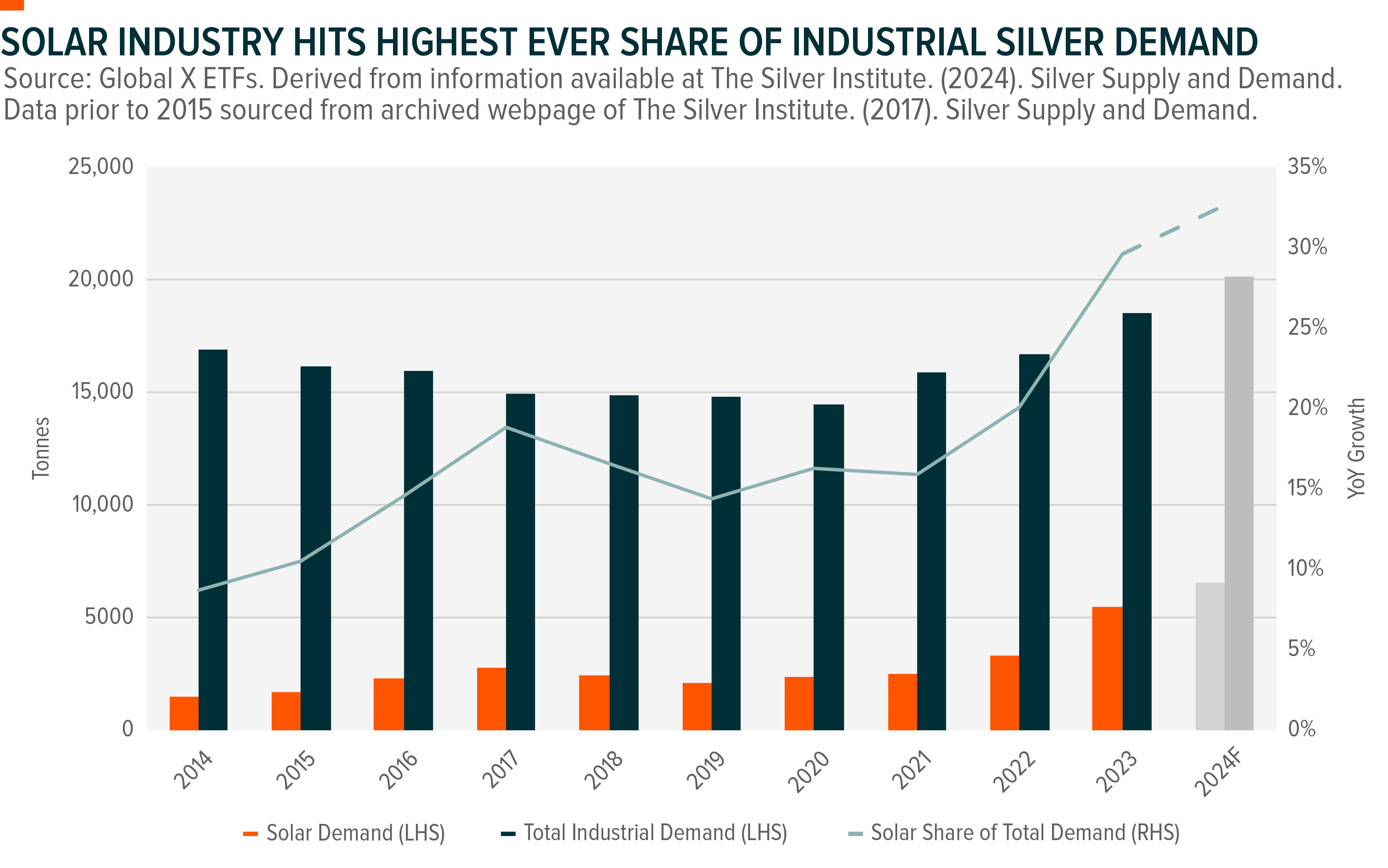
Forecasts based on views held by The Silver Institute as at 29/05/2024.
And expand the solar industry shall, or has done, so to speak. According to Andrew Blakers, Professor at Australian National University and a pioneer in photovoltaicsii, new solar capacity is being installed at a faster pace than any other energy technology in history.(15) Since the signing of the Paris Agreement in 2016, solar installed capacity has grown at a compound annual growth rate (CAGR) of 24% compared to 11%, 2% and 0.4% by wind, hydro and nuclear respectively.(16) Overall, global solar install base has grown tenfold in the past decade, surpassing 1.4 Terawatts (one trillion watts) as of 2023.(17)
Looking ahead, should the solar industry continue to grow at its current rate, worldwide solar power could approach 9TW in 2031 – more than the current total for electricity generated through gas, and almost enough to fully offset crude oil.(18) In a world like that, annual silver demand from the solar industry would exceed 23 kilotonnes, more than the total industrial demand today and 82% of total silver supply in 2023.(19)
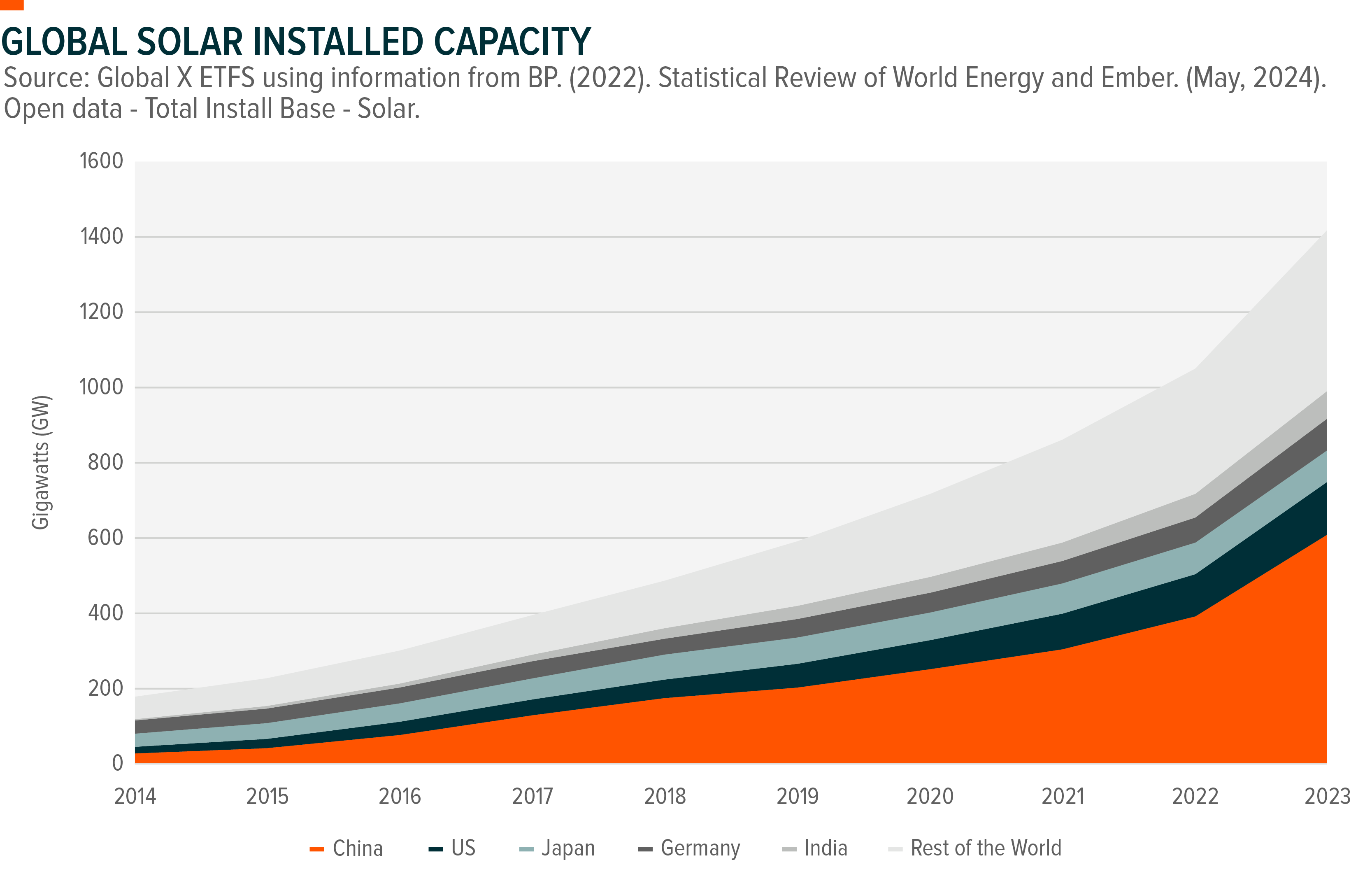
EVs Will Also Drive Silver Demand
The electrification of the automotive industry is also showing signs that it may be a major contributor to the growth of silver demand over the next decade. Here, silver is used in the construction of batteries, coating for electrical contacts, and components within computer chips.
Compared to the solar industry, silver usage in the auto industry is relatively small, but the transition to EVs has meaningfully increased their exposure. According to estimates by the Silver Institute, the average internal-combustion vehicle (both petrol and diesel) uses between 15-28 grams of silver, 18-34 grams for hybrids, and roughly 25-50 grams per EV.(20) Should those statistics hold true, the global transition to EVs represents a potential doubling of silver demand from the auto industry. To form a rough projection of this growth, we looked at historical data of EV purchases from the IEA database, multiplied by estimated silver usage, and calculated the amount of silver the industry is currently putting to use.
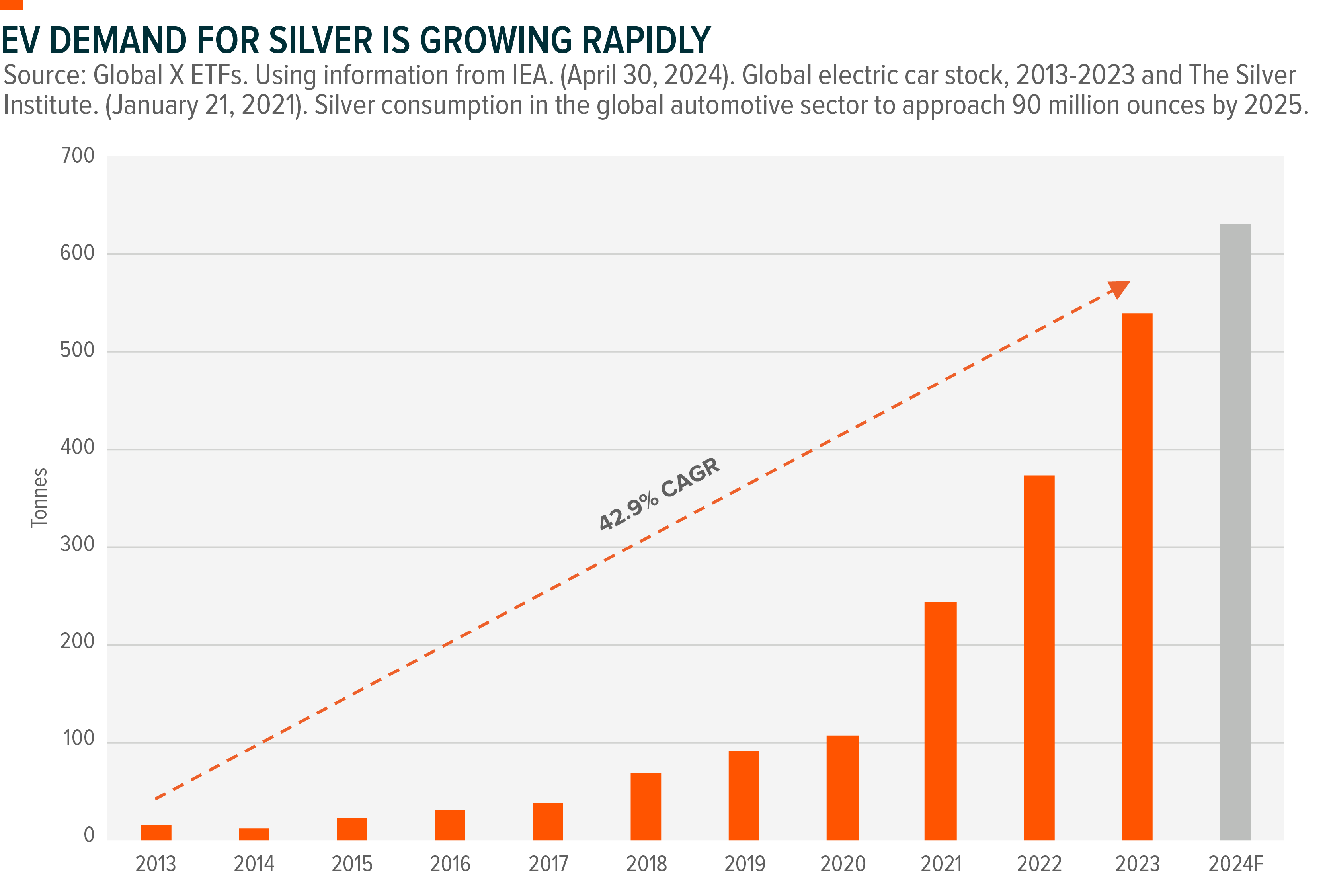
Forecasts based on views held by The Silver Institute and IEA as at 29/05/2024.
Referring to the chart above, we estimate that silver demand from EV production has grown at a CAGR of 43% over the past 10 years, culminating in ~540 tonnes of silver used in 2023. That figure represents 2.9% of silver’s total industrial demand, which while small, is up almost 30x from only 0.1% in 2013.(21) Looking ahead, EV adoption is a non-negotiable megatrend for a net-zero future – as such, demand for silver from the industry will inevitably grow. From there, a revolution toward autonomous vehicles may drive further increases as more complex circuitry and computer systems demand more silver use.
The Current Supply Picture
So far this insight piece has only discussed half of the future supply and demand picture for silver. Demand growth is, in general, a good omen for inflating prices, but that relationship falls flat if supply can grow in tandem. Luckily for investors, silver appears to have entered an era of significant supply deficits.(22)
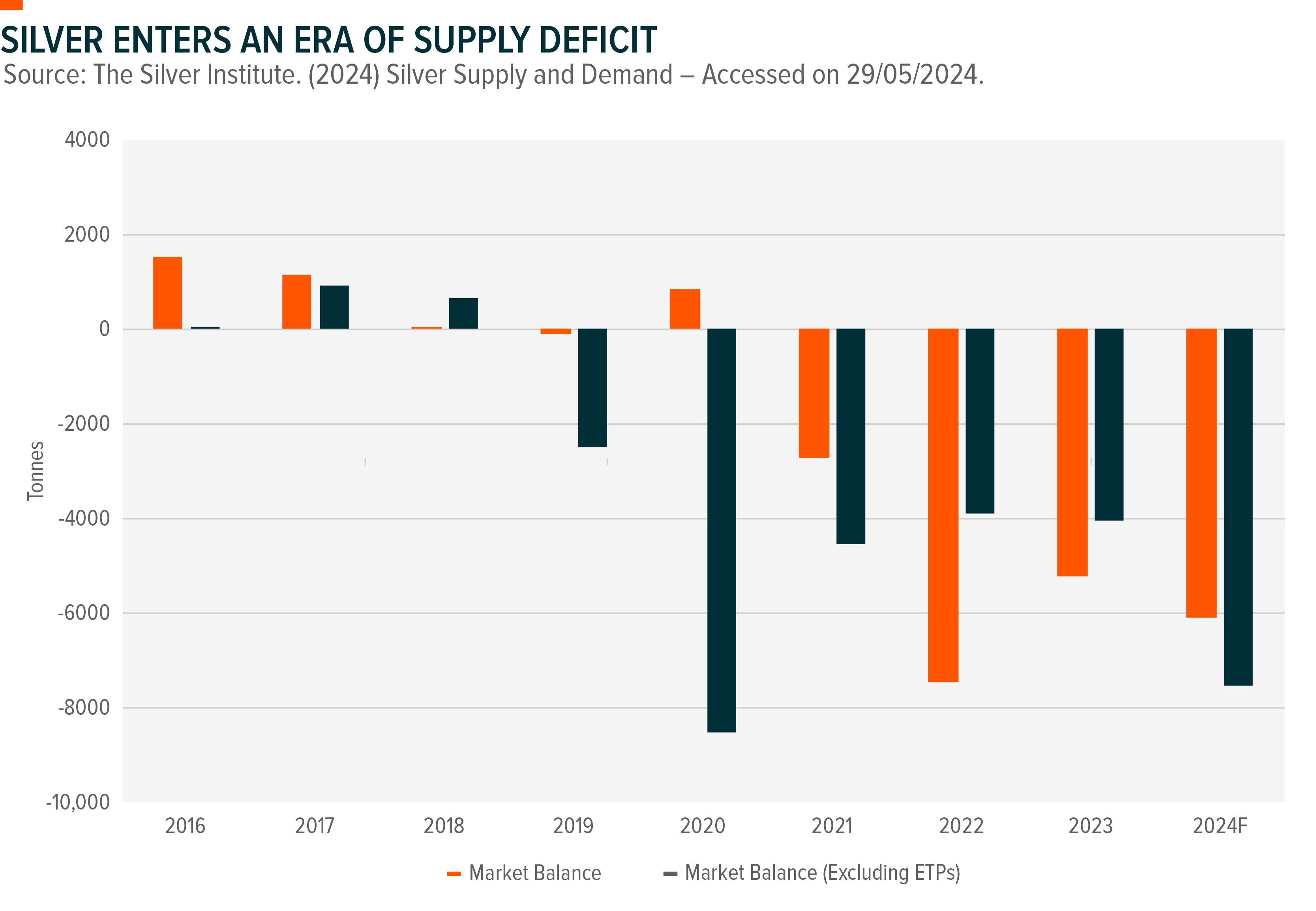
According to the Silver Institute’s latest World Silver Survey, the silver market marked its third consecutive year of supply deficits last year – or its fifth if investments (such as exchange traded products) are excluded.(23) The reason for this continuous imbalance is evident upon observing the negligible growth of silver production over the past decade. Mines across the world produced 23,340 tonnes of silver in 2013, today they produce a total of 23544 tonnes.(24) Silver industrial demand, on the other hand, has grown at a rate of 4.5% (over five years) after a period of relative stagnation prior to 2018, and last year, total silver demand rose 18% to a record high of 35,150 tonnes, creating a supply deficit of around 7,500 tonnes.(25,26)
There are two main reasons why silver production hasn’t increased to match growing demand. First is a lack of price incentive. Expanding silver mining capacity simply has not been an attractive proposition over the past decade. From 2014 to early 2020, the price of silver demonstrated almost zero upside, trading range bound between US$20-25 per pound for the majority of the period.(27) Miners seek expansion when commodity prices rise. Thus, with silver prices stagnant, there has been less incentive to build out new mines or facilities.
Secondly, the make-up of the silver supply chain does not scale as naturally as other metals. Unlike copper or iron, silver is produced mostly as a byproduct in the process of mining other metals. This is because pure silver deposits are rare, much like gold, but it does often appear in chemical mixtures of other metals such as copper or zinc – making it a good source of low-effort revenue for non-silver miners. As of 2023, only 28.3% of the global silver supply is mined from silver-primary mines, the rest are all as byproducts of other metals.(28) This relatively unique dynamic means that silver production relies heavily on the expansion of ‘non-silver’ miners, who have no intrinsic incentive to increase capacity for a non-target metal.
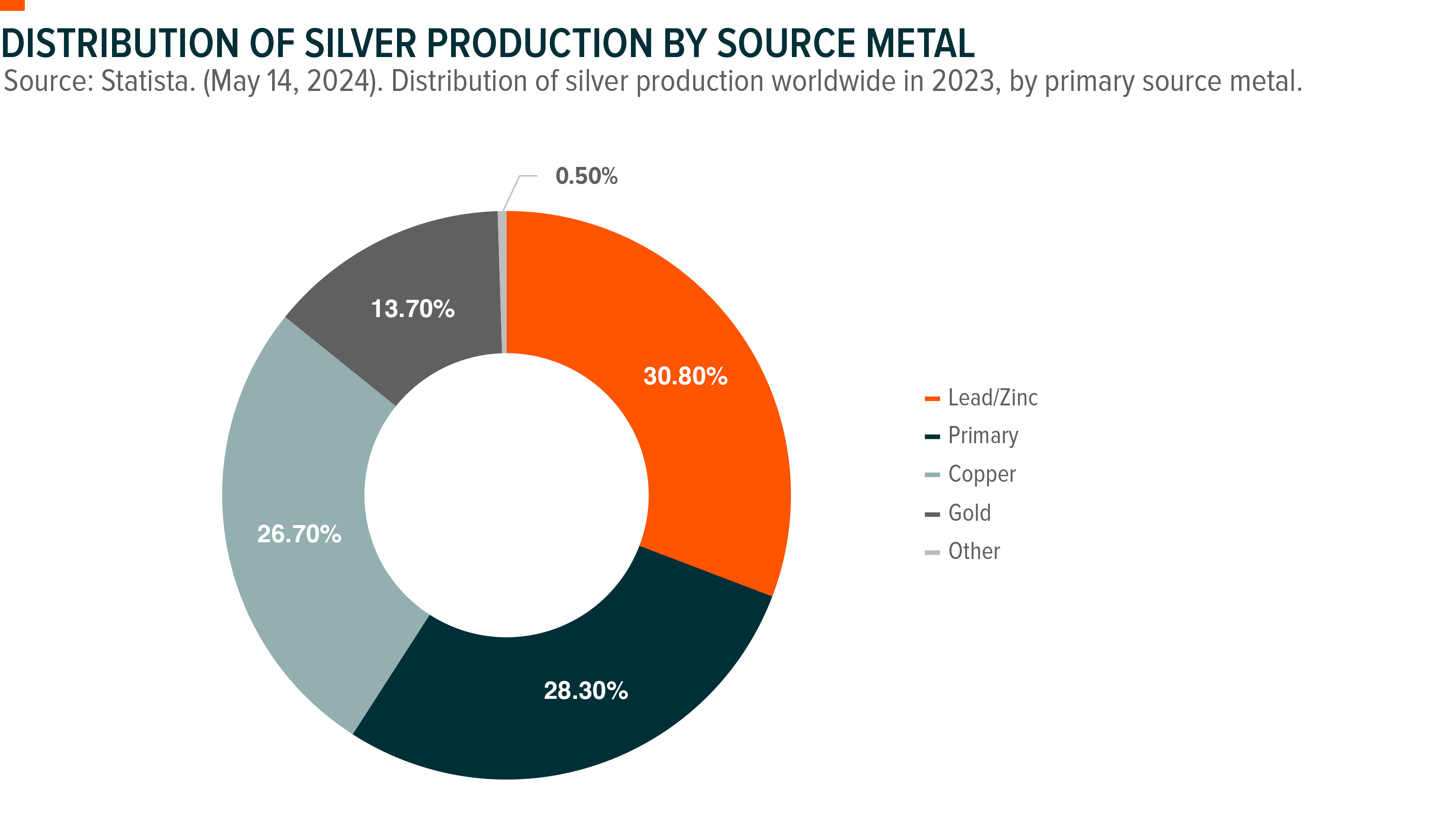
Conclusion: Silver’s Investment Case is Evolving
Silver has always been an enigmatic investment within the commodities space. It’s half precious metal, half industrial material – half safe haven asset, and half economy dependent. But with the spotlight on silver as we head into the second half of 2024, there has been a distinct shift in how investors view the metal’s future. Solar and electrification represent clear sources of rising demand, while supply growth appears frozen with no apparent path forward.
For the first time in a long time, silver is exciting again. It has become a key participant in a major trend sweeping across the world – and with its participation may come an opportunity that is open for capitalising.
Related Funds
The Global X Physical Silver ETF (ASX: ETPMAG) invests in physical silver via the stock exchange. Learn more via our website or fund profile below.

1 topic
1 stock mentioned
1 fund mentioned

